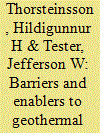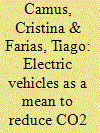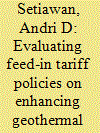|
|
|
Sort Order |
|
|
|
Items / Page
|
|
|
|
|
|
|
| Srl | Item |
| 1 |
ID:
094224


|
|
|
|
|
| Publication |
2010.
|
| Summary/Abstract |
According to the US Energy Information Administration, space and hot water heating represented about 20% of total US energy demand in 2006. Given that most of this demand is met by burning natural gas, propane, and fuel oil, an enormous opportunity exists for directly utilizing indigenous geothermal energy as a cleaner, nearly emissions-free renewable alternative. Although the US is rich in geothermal energy resources, they have been frequently undervalued in America's portfolio of options as a means of offsetting fossil fuel emissions while providing a local, reliable energy source for communities. Currently, there are only 21 operating GDHS in the US with a capacity of about 100 MW thermal. Interviews with current US district heating operators were used to collect data on and analyze the development of these systems. This article presents the current structure of the US regulatory and market environment for GDHS along with a comparative study of district heating in Iceland where geothermal energy is extensively utilized. It goes on to review the barriers and enablers to utilizing geothermal district heating systems (GDHS) in the US for space and hot water heating and provides policy recommendations on how to advance this energy sector in the US.
|
|
|
|
|
|
|
|
|
|
|
|
|
|
|
|
| 2 |
ID:
112243


|
|
|
|
|
| Publication |
2012.
|
| Summary/Abstract |
Most of small islands around the world today, are dependent on imported fossil fuels for the majority of their energy needs especially for transport activities and electricity production. The use of locally renewable energy resources and the implementation of energy efficiency measures could make a significant contribution to their economic development by reducing fossil fuel imports. An electrification of vehicles has been suggested as a way to both reduce pollutant emissions and increase security of supply of the transportation sector by reducing the dependence on oil products imports and facilitate the accommodation of renewable electricity generation, such as wind and, in the case of volcanic islands like São Miguel (Azores) of the geothermal energy whose penetration has been limited by the valley electricity consumption level. In this research, three scenarios of EV penetration were studied and it was verified that, for a 15% LD fleet replacement by EVs with 90% of all energy needs occurring during the night, the accommodation of 10 MW of new geothermal capacity becomes viable. Under this scenario, reductions of 8% in electricity costs, 14% in energy, 23% in fossil fuels use and CO2 emissions for the transportation and electricity production sectors could be expected.
|
|
|
|
|
|
|
|
|
|
|
|
|
|
|
|
| 3 |
ID:
186452


|
|
|
|
|
| Summary/Abstract |
Geothermal is vital for sustainably meeting Indonesia's energy demand, given its estimated massive reserves potential equivalent to 24 GW of electricity. The Indonesian government has set geothermal contributions to the national energy mix at 7,241.5 MW by 2025 and 17,546 MW by 2050, despite harnessing such vast potential needing significant investment. To that goal, the government established a feed-in tariff (FIT) mechanism to encourage private sector investment in geothermal development. However, FIT has undergone significant alterations in a short period. Moreover, various complicating factors—bureaucracy, social, and technical—exist alongside FIT implementation. Therefore, the extent that FIT can effectively enhance geothermal development in Indonesia should be challenged with further investigation. This study explores the efficacy of FIT policies for geothermal electricity by comparing the performance of several FIT schemes in terms of their impact on the government's target achievement. This study combines the policy analysis framework with system dynamics modeling to understand the dynamic interaction of FIT policy and other important components in geothermal development. The findings show that modest bureaucracy and public support are required. Furthermore, to enhance geothermal development more effectively, FIT should be at least 11 cents US$/kWh and accompanied by technical breakthroughs and government-funded exploration activities.
|
|
|
|
|
|
|
|
|
|
|
|
|
|
|
|
|
|
|
|
|